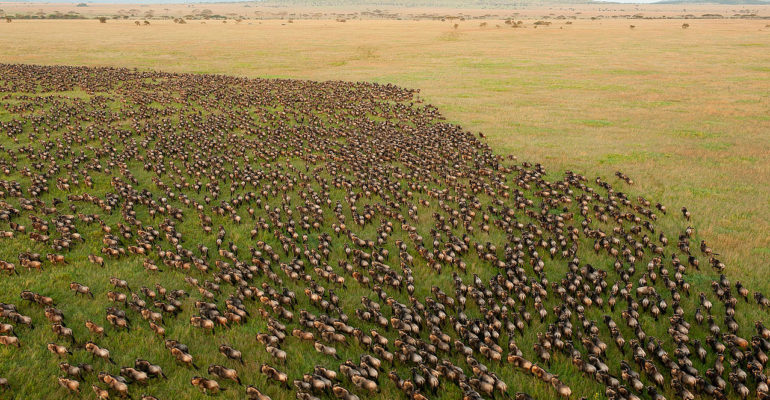
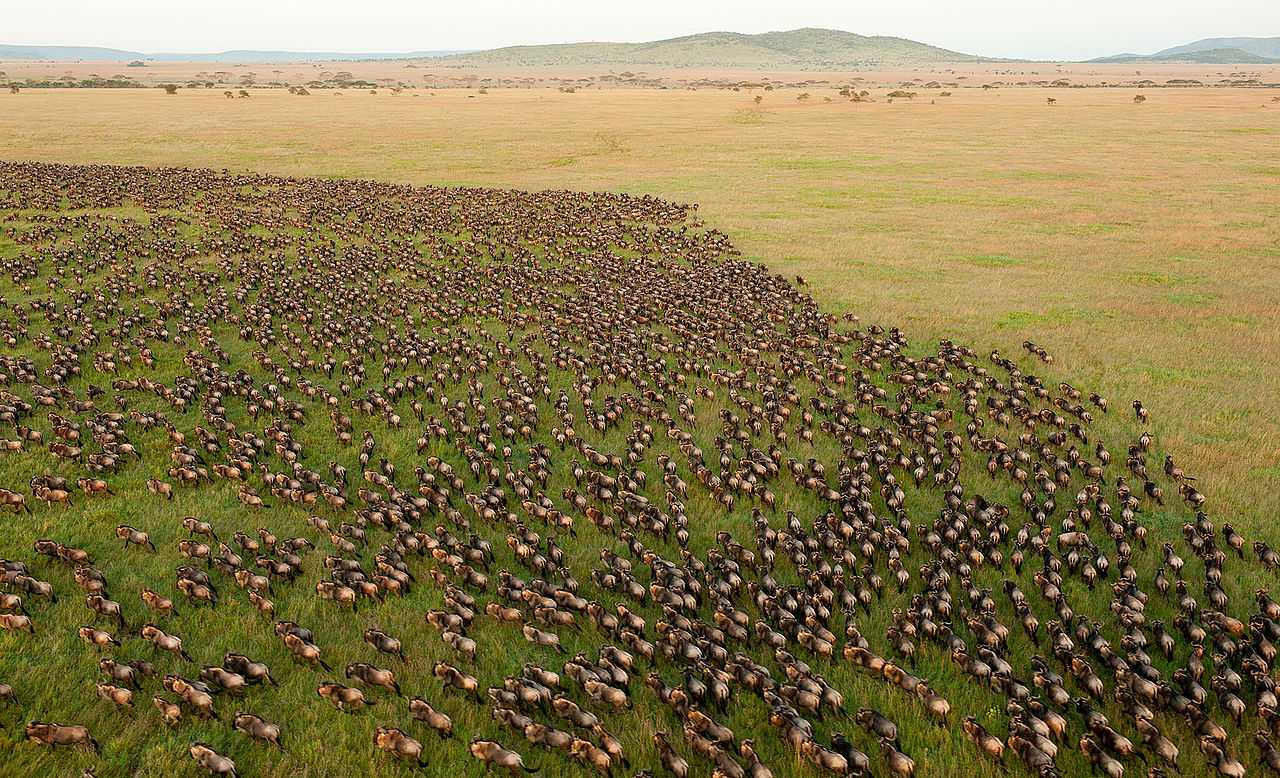
Wildebeest Migration in Serengeti National Park, Tanzania Photo: Daniel Rosengren
Local tourism operator Dr Dennis Tafe shares his thoughts on opportunities for nature based and education based tourism in Africa and the Redlands.
R2030 You’ve been successfully managing educational marine trips for our local colleges and overseas students since 2009. Where do you take them and why is this important?
A Moreton Bay comprises one of the largest and most bio-diverse marine habitats in Australia. Deadman’s Beach is good for rock platform and mangrove studies and Brown Lake for fresh water studies plus other special places I know where important studies can be interesting and valuable for students. We average 5 field trips over 2 days for maximum benefit and then return for laboratory work with microscopes, which fits with the National Science Syllabus.
R2030 Why is it important to study mangroves?
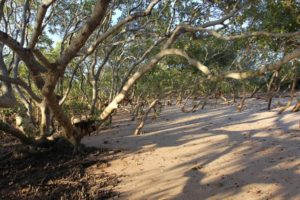
Mangroves near Toondah Harbour
A Mangroves are the only type of trees that can grow in salt water and the only trees to have mechanisms that can get rid of salt. There’s approximately 9 species around Australia and five of these are on the eastern coast. I can take people to a place that has all 5 species. Some can grow in full sea water. We all learn at school that Captain Cook discovered Australia in 1770 but the Aborigines have been here for thirty thousand years. Schools are now making Aboriginal culture and heritage an essential element of the school curriculum.
R2030 How did you first become interested with educating students in marine biology?
A I qualified in 1995 with a PHD in marine biology when there were very few jobs for marine biologists. I had previously worked as a high school science teacher, a biologist for CSIRO and a lecturer in biology at University Dar es Salaam in East Africa. In 1995 I worked for Queensland Museum and later lectured to Queensland TAFE colleges. Five years later I was working with a group of biologists in the Galapagos Islands. I came back to Queensland and published papers on the ecology of Moreton Bay.
By 2005 I was out on my own consulting and registered Dr Tafe Marine Safaris after receiving a federal business grant for start-ups. I have published for Tokyo Institute of Cetacean Research, been on TV segments for tourism in Great South East and worked with Ranger Stacey on Totally Wild promoting the natural beauty of Moreton Island.
R2030 This exposure must have opened a lot of doors for you, especially tourism on Great South East segment. Where did it take you?
A Working on these shows was exciting and I got calls offering business support from Redland City Council (RCC) after they saw me on TV. It was very good for a while but then people in charge of tourism at RCC seemed to be more interested in other areas so I wrote to council in 2009 and expressed my disappointment at the loss of Tourism in Redlands. This was the time I knew I had to switch to educational studies as tourism wasn’t being supported.
R2030 So where are you at now with the marine safaris?
A When Moreton Bay tourism was no longer profitable we changed our expedition to Africa and now take 4WD tours to see lions, cheetahs and the wildebeest migration in the Serengeti. In 2012 we launched our first big safari to Tanzania and Kenya. It was so successful we did it again the following year to experience the wildebeest migration and see the rhinos while they are still here. If that’s not on your bucket list, it should be.
R2030 What made you include Africa in your safaris?
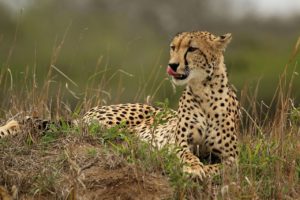
Cheetah in Africa – Photo: Sharp Photography
A In 2000 I paid a lot of money to go on a safari trip with a large travel company to South America. We were a few days into the trip when the guide came to us and said we were to all meet in the morning and it was compulsory for us all to be there. We thought they were going to tell us something exciting like an add-on to the trip.
Instead we were told the tourist operator had gone into receivership and in 24 hours we were on our own. We were in one of the wildest places on earth. This can be a dangerous place and safety is vital. Half the people had no insurance for this and lost all their money. I was okay and managed to find accommodation but others had no idea what to do so we helped them through it. This was the moment we thought ‘blow this for a joke’ we can do our own safari. If the owners are on the trip and there’s no staff then we can guarantee we won’t leave anyone stranded.
R2030 Safari’s through wild Africa can cost thousands and be out of reach for many people. As a private operator how do you compete on price?
A We offer people a superior safari where safety takes precedence at half of the price of travel companies. Dr Tafe Safari’s is the only Australian company offering private tours. We only take small groups in 4WD’s and offer all-inclusive tours with glamping accommodation, including flushing toilet and warm water shower. We drive through remote areas so you can see lions, elephants and herds of wildebeest and zebras up close. We include lodges in our accommodation, getting the best out of our trip. There’s nothing to pay once you get there, giving our travellers great bang for their buck and they travel safe and secure and we guarantee no one will be left stranded. Some of these areas can have dangers if there is only one or two of you.
R2030 So what’s your next trip?
A We have a few seats left for our 8 day trip to Africa in September.
We are going to Tanzania to coincide with the wildebeest migration. It’s in school holidays so ideal for a family trip but can’t take children under 13. We include a night at Ngorongoro Crater Lodge on the rim of Ngorongoro Crater. It’s one of the most romantic places on earth when the sun is setting. We want to include Olduvai Gorge in Northern Tanzania because that is where the early remains of Man were found. While in the Serengeti our group will see the spectacular display of pink flamingos in Lake Manyara National Park and more spectacular sunsets.
R2030 Besides personalised travel and safety what do you do that big tourism operators don’t?
A We offer add on tours for those that want a bit more in their tours such as St Jude’s School for the Poor and a trip to Stone Town on Zanzibar – an island where nothing has changed in 150 years. It’s a travel back in time experience and has the most amazing architecture. Anyone is welcome to join in and I know places tourist operators can’t go.
R2030 What about tourism in Redlands, do you see an opportunity?
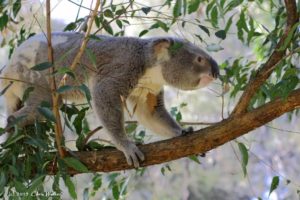
Koala in the Redlands
A Tourism in Redlands has been going downhill and I have grave concerns and have written many letters expressing my concerns.
Some replies I find difficult to make sense of at all. I have huge concern for our defenceless koala population, which is being depleted. As a biologist I can say the important aspect of koalas is habitat. If RCC spends $30,000 for chlamydia clinic trials it will not conserve the total koala population. Leah and I saw in Borneo they had huge palm oil plantations and orangu-tans cannot live there. So, again habitat is the crucial factor. And yes, next year’s project may be a trip to Borneo to see the orangutans before they are lost forever.
Interviewee details
Dr Tafe Safaris: Doctor Dennis Tafe
Marine Biologist
Phone: 0421 548 755
email: dennistafe@yahoo.com
Web site details:
You tube stories:
- Freshwater study on Moreton Island
- Sand dune succession study on Moreton Island
- Preview our Marine Biology Study Tours
- Dr Tafe – The Great South East
Redlands2030 – 12 April 2017
Please note: Offensive or off-topic comments will be deleted. If offended by any published comment please email thereporter@redlands2030.net
2 Comments
WHERE in Redlands can tourists be taken to view koalas in the wild? The Redlands community have been helpless, try as they might, to save habitat from being destroyed…but here there is no government body that allows for retention of koala habitat. Developers with deep pockets make the final decision while State and local government politicians turn a blond eye to killing off the Redland koala population for non-stop housing estates in many forms as human habitat is what matters for obvious reasons. While Redlands Town Plan has no policy in retaining kola habitat, it is admirable that even with continued loss of wildlife habitat we have dedicated conservationists fighting to preserve habitat where they can, and bush/wildlife carers find areas to plant new habitat in hopes of saving the species from extinction. With 80% of koala population in SEQ having vanished, could all three levels of government please buy habitat to preserve the remaining few in Redlands so in future, we too can have the pleasure of showing off our unique marsupial to visitors and tourists alike bearing in mind extinction is forever?
We only have space for 2 more people on September Wildlife Safari to Serengeti.
Agree fully with Amy Glade.